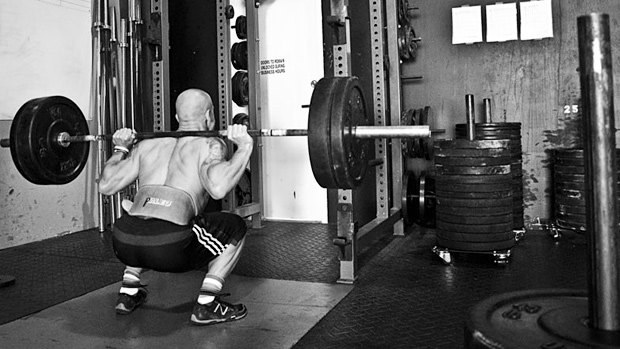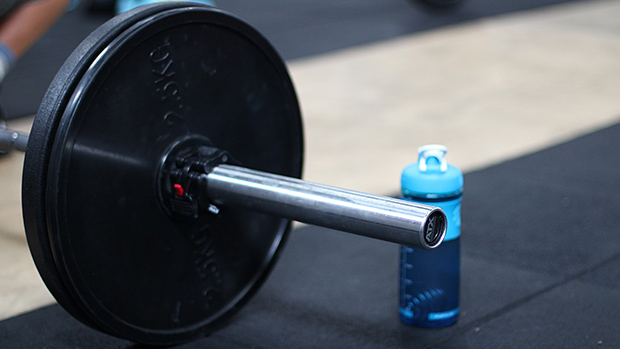There are loads of different ways to get stronger. Similarly, there are all sorts of different classifications of strength, whether you're a powerlifter, strongman, Olympic lifter, manual laborer, or just some random dude who wears his hat like Sylvester Stallone in "Over the Top" and constantly seeks out arm wrestling matches in airports, bingo halls, or massage parlors.
While there are general principles like progressive overload that govern how everyone gets stronger regardless of the chosen loading protocol, certain schemes are simply more effective than others when it comes to adding weight to the bar.
Below, I put five such schemes under the microscope and highlight where they are wisely applied – or completely inappropriate.
1 – Linear Periodization
In kicking this point off, I should state emphatically that any form of periodization works better than no form of periodization. As with most things in life, throwing a bunch of shit on the wall to see what works is rarely an optimal way to get things done.
Traditional linear periodization includes multiple phases in succession: muscular endurance, hypertrophy, strength, and power (although in the non-athletic realm, the power phase is usually skipped). The idea, in theory, was good for peaking athletes for a big event at the end of the power phase. There were a few problems, though:
- One simply can't maintain proficiency in the qualities developed as he/she moves to subsequent phases. For instance, the strength developed in the first go-round would be largely lost by the time the athlete reached the hypertrophy portion of the second. Or, an athlete struggles to maintain muscle mass (hypertrophy) through the power phase.
- Not all athletes have to peak for a specific event; more commonly, athletes have long, grueling competitive seasons. So, which phase do you use during the season?
- Just imagine how your joints would feel if you ONLY trained for strength during an entire training session for an entire phase of your training. Think you might be a little banged up? Yep.
Some people have tried to throw out the argument that linear periodization is a good fit for beginners because the endurance phase gives them a chance to get in plenty of practice reps and build up connective tissue strength, but I couldn't disagree more. Why?
What does a beginner look like on a set of 12-15 reps of squats or deadlifts? Maybe the first 4-5 look good, and then he/she is just engraining faulty movement patterns for the latter two thirds of the set. Crazy fatigue is not what you want when you're trying to teach technique and get someone started on the right foot.
Summing up, linear periodization might be better than nothing, but that still doesn't make it an effective approach for beginners or more experienced lifters looking to get bigger, stronger, or both. Stick to nonlinear modalities and you'll be much better off; trust me.
2 – 5x5
The 5x5 approach is one that's gained a lot of popularity in a "resurgence" since it was originally introduced quite some time ago. Fact is, it's so popular that some folks use it exclusively...all the time...for their entire lives. Sadly, I'm not joking.
First, let's talk about the good. The 5x5 approach is an effective modality for taking beginners to the intermediate stage. If you've spent your entire life doing 3x10-12 (as most people do when they start lifting based on what they read in the bodybuilding magazines), moving to a lower rep-range clearly makes sense as an avenue for continued progress beyond the "newbie gains."
Not progressing to these heavier sets of 4-7 reps is, in my eyes, one of the biggest mistakes novice lifters make in their first year of training. This is true whether the goal is size or strength (or both).
So, to that end, I think 5x5 is an excellent option in your first two years of lifting; it gives you plenty of volume to stimulate muscle growth, forces you to work at a higher percentage, and allows for enough repeated efforts to continue to build the movement efficiency it takes to get stronger.
Unfortunately, many folks stop there and 5x5 becomes like that first girlfriend in high school who let you get your grope on before dumping your sorry ass; it felt right, so you just can't seem to let her go.
I can say without wavering that in all my experience of coaching athletes and fitness enthusiasts, the biggest mistake that intermediate lifters make on their road to getting stronger is not working below five reps on the main strength exercises.
If you look at the research on the "evolution" of a lifter, you get a clear picture that intensity – and not volume – is the factor that governs how sustainable progress is over a training career.
Untrained lifters can improve strength with as little as 40% of their 1-rep max. In other words, if your naturally well-built friend could (theoretically) squat 225-230 pounds on his first day of training, he could likely improve his squat by just "practicing" with the bar and a 25-pounder on each side.
As he gets more experienced, though, that minimum threshold for strength improvements goes up to 70% of 1RM in intermediate lifters (roughly a 12-15 RM load for most lifters). Eventually, you'll need at least 85-90% of 1RM in advanced lifters to get any sort of a strength gain (or even strength maintenance).
So what does this mean for the 5x5 setup in experienced lifters? I recall Charles Poliquin writing on numerous occasions that the average intermediate lifter can handle 85% of his 1RM for approximately five reps. Taking this a step further, only your heaviest set of five (presumably the first or second one in a series of five sets) would actually create a training effect capable of stimulating a strength improvement.
With 5x5, you do 25 reps – but only about 5-10 of them (the first set) are performed at a high enough intensity to elicit strength gains. And, as you get even more experienced, 85% won't even cut it (you have to be closer to or above 90%) – so you won't find many elite level strength athletes doing many sets of five for their "strength work."
With all this in mind, use 5x5 if you're a beginner or intermediate lifter looking to get stronger, but don't do it for years on end. You'll stop getting stronger eventually.
3 – Wave Loading
I took issue with the use of wave loading for enhancing maximal strength a while back in It Looked Good On Paper, and if I can blow a little sunshine up my own butt, I think I did a pretty good job of it.
With that in mind, though, I think it warrants mention that wave loading does have some utility when it comes to building muscle mass. More specifically, the lower-rep sets tap into some higher threshold motor units and enable one to use more load during the "back-off" sets – which occur in what we've come to recognize as our best rep ranges for building muscle.
So, to recap, wave loading has some definite benefits for building muscle mass, but I wouldn't wipe my ass (or anyone else's ass, for that matter) with it for building strength.
4 – Percentage-based Training
I'll be honest, I've never been much of a fan of percentage-based training. Sure, it has its place when we're talking about moving lighter loads with a lot of speed (whether it's Olympic lifts, jump squats, speed bench, or something else), but I just don't think this style of training takes into account the fact that people actually get stronger. It's a strange concept, I know.
I mean, think about it: The programs in each of my last two books have lasted 16 weeks, or four 4-week phases. It wasn't uncommon to see people put over 100 pounds on their squats and deadlifts and 50 pounds on their bench presses and 3-rep max chin-up.
Since it isn't possible to retest one's 1RM on every exercise, when you use percentage-based training, you're often basing your percentage on a 1RM that is months old.
Let's say you're a 300-pound squatter at the beginning of a 16-week program, and I want you to use 78% of your 1RM for three sets of six reps. You'd be using 235 pounds.
Now let's say that I want you to do the same 78% for 3x6 12 weeks later when your best squat is up to 360 pounds.
You'll still be using 235 when you ought to be using 280 pounds. In other words, percentage-based training – at least in a beginner and intermediate population – becomes very inferior, very quickly.
There is, however, a time (beyond speed work) when percentage-based training does come in handy: when one sucks at pushing oneself. When we're talking about someone who is a bit lazy and tends to underestimate his or her abilities, keeping them accountable to a percentage can be a good way to make sure they don't turn into a complete pussy when they get to the gym.
This is one reason why percentage-based training has become somewhat popular in collegiate settings: For every hardworking athlete, you usually have another 2-3 who just want to get their "conservative" reps in because they're too hung over to take the lift seriously.
Giving them a percentage to work from at least reminds them that they suck at life – and ensures that they do a little more work. Unfortunately, it can also hold the best athletes back a bit.
With all this in mind, percentage-based training is generally not a good idea unless one, a) is very experienced and strong, b) has a clear idea of almost exactly what his 1RM is, or c) is a waste of space that needs a percentage to keep him honest.
5 – 8x3 or 10x3, etc.
Eight sets of three, ten sets of three, and the like have gained popularity around here thanks to the writing of Chad Waterbury – and with good reason: they're an excellent fit for the "typical" TNation reader who wants a decent blend of size and strength.
On one hand, getting in 24-30 reps is surely enough work to create a stimulus for muscle growth. On the other hand, sets of three are generally at a high enough percentage to yield some appreciable strength gains, especially in intermediate lifters. So, effectively, you get some of both worlds.
However, you don't get the best of both worlds, particularly regarding strength development.
In the case of 8x3 or 10x3, those interested in strength gains almost exclusively run into the same issues as we saw with 5x5: many of the sets may fall below the requisite percentage of 1RM to induce strength gains.
Additionally, this volume of high-percentage work would wipe out most advanced lifters. As a frame of reference, my best deadlift is 660 pounds. Given that the typical lifter can hit a set of three at 90% of his 1RM, that'd put my 3RM at 595 pounds. Doing ten sets of three at 595 pounds – or even 550 pounds, for that matter – would be completely unsustainable for me, and likely pretty dangerous.
About two months ago, I hit 550 for 3x3, and afterwards wanted to go into hibernation for the entire winter because I was so exhausted and beaten down. The thought of doing another 5-7 sets at that load is laughable. The truth is that while I've pulled 660, I might only pull over 600 pounds 4-5 times per year.
A guy like me can, however, benefit from including some 8x3 and 10x3 work sparingly throughout the training year, and by doing it at a slightly lower percentage of 1RM than more intermediate lifters.
Summarily, 8x3 and 10x3 schemes offer a good blend for those looking for efficient ways to get bigger and stronger at the same time, but they may be too much for more advanced lifters unless they're used sparingly and performed at a lower percentage of 1RM. As with 5x5, use them, but not all the time, and certainly not forever.
Conclusion
Of course, these five approaches are just the tip of the iceberg when it comes to sets and reps protocols that I could put under the microscope. Feel free to comment in the article LiveSpill on systems that have or haven't worked well for you.





